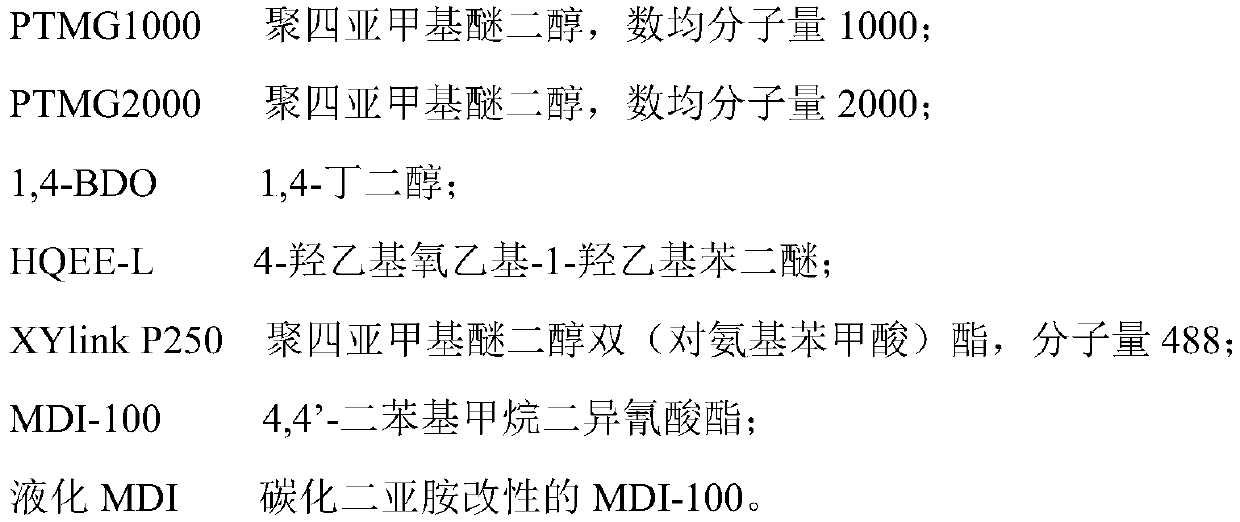Preparation method of polyurethane elastomer with adjustable hardness
A polyurethane elastomer and hardness technology, applied in the field of polyurethane application, can solve the problems of inability to achieve high hardness, long demolding time, narrow hardness range, avoid delamination and high temperature decomposition or denaturation, excellent processing performance, widen Effect of hardness range
- Summary
- Abstract
- Description
- Claims
- Application Information
AI Technical Summary
Problems solved by technology
Method used
Image
Examples
Embodiment 1
[0046] The preparation method of the polyurethane elastomer with adjustable hardness described in Example 1 includes the following steps:
[0047] (1) A component 331.8kg: PTMG2000 is dehydrated to a moisture content of 0.03% under the conditions of a temperature of 120°C and a vacuum degree of 0.095MPa, and 1.8kg of triethylenediamine catalyst is mixed uniformly to obtain component A;
[0048] (2) 100 kg of component B: 25.0 kg of PTMG2000, 52.5 kg of MDI-100, and 22.5 kg of liquefied MDI are reacted at 75°C to obtain a prepolymer with an isocyanate content of 23.0%;
[0049] (3) 9.3kg of C component: 9.3kg of 1,4-BDO, dehydrate 1,4-BDO to a moisture content of ≤0.03% as component C.
[0050] The method for preparing a polyurethane elastomer with adjustable hardness using the above three-component composition is as follows:
[0051] Mix the A component and C component prepared above, and then mix and stir evenly with the B component. The mixing temperature is 50 ℃, and the preheating t...
Embodiment 2
[0053] The preparation method of the polyurethane elastomer with adjustable hardness described in Example 1 includes the following steps:
[0054] (1) A component 253.3kg: Dehydrate PTMG1000 at a temperature of 110°C and a vacuum degree of 0.095MPa to a moisture content of ≤0.03% and 1.8kg of tetramethylethylenediamine catalyst to obtain component A;
[0055] (2) 100kg of component B: 21.0kg of PTMG2000, 47.4kg of MDI-100, and 31.6kg of liquefied MDI are reacted at 80°C to obtain a prepolymer with an isocyanate content of 23.0%;
[0056] (3) C component 11.3kg: 11.3kg XYlink P250, dehydrate XYlink P250 to a moisture content ≤0.03% as the C component.
[0057] The method for preparing a polyurethane elastomer with adjustable hardness using the above three-component composition is as follows:
[0058] Mix the A component and the C component prepared above, then mix and stir evenly with the B component at a mixing temperature of 50°C, pour into a mold with a preheating temperature of 90°C,...
Embodiment 3
[0060] The preparation method of the polyurethane elastomer with adjustable hardness described in Example 3 includes the following steps:
[0061] (1) A component 100.6kg: Dehydrate 100.0kg of PTMG1000 at a temperature of 100°C and a vacuum of 0.095MPa to a moisture content of ≤0.03% and 0.6kg of bismuth laurate catalyst to obtain component A;
[0062] (2) 100 kg of component B: 25.4 kg of PTMG1000, 59.7 kg of MDI-100, and 14.9 kg of liquefied MDI were reacted at 80°C to obtain a prepolymer with an isocyanate content of 22.0%;
[0063] (3) C component 13.9kg: 13.9kg of 1,4-BDO, dehydrate 1,4-BDO to a moisture content of ≤0.03% as component C.
[0064] The method for preparing a polyurethane elastomer with adjustable hardness using the above three-component composition is as follows:
[0065] Mix the A component and C component prepared above, then mix and stir evenly with the B component at a mixing temperature of 60℃, pour into a mold with a preheating temperature of 110℃, and open the...
PUM
| Property | Measurement | Unit |
|---|---|---|
| hardness | aaaaa | aaaaa |
| hardness | aaaaa | aaaaa |
| hardness | aaaaa | aaaaa |
Abstract
Description
Claims
Application Information
 Login to View More
Login to View More - R&D
- Intellectual Property
- Life Sciences
- Materials
- Tech Scout
- Unparalleled Data Quality
- Higher Quality Content
- 60% Fewer Hallucinations
Browse by: Latest US Patents, China's latest patents, Technical Efficacy Thesaurus, Application Domain, Technology Topic, Popular Technical Reports.
© 2025 PatSnap. All rights reserved.Legal|Privacy policy|Modern Slavery Act Transparency Statement|Sitemap|About US| Contact US: help@patsnap.com


